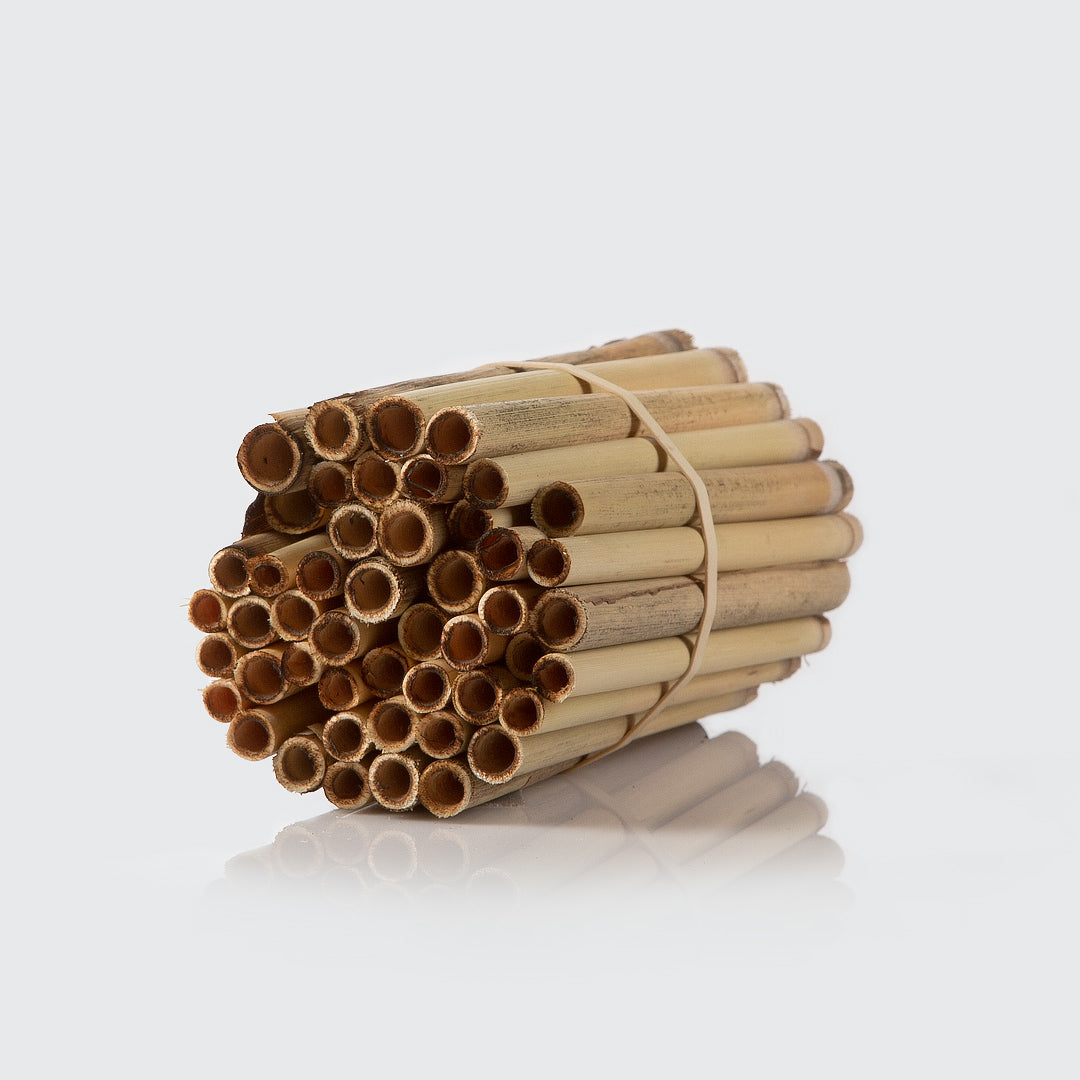How to Clean Out a Bee House with Reeds
1- Take down bee house when bees stop flying (usually September)
It is important to clean out the bee house when the bees are not in the pupa stage of development. While the bee is in the pupa stage it is white and sticky. Handling the cocoons while the bees are sticky can result in a deformed bee. Wings or legs may get stuck to the body and the bee won’t be able to move normally.

Mason bees and other spring time bees should be fully developed waiting to hibernate for the winter by mid September. If you are curious what developmental stage the bees are in it’s always fun opening up a cocoon (just be sure to choose a smaller cocoon because they are usually male and less valuable).
Alfalfa leafcutter bees (summer time bees) will be in the larvae stage and won’t be damaged during clean out in the fall.
2-Gather Supplies:
Cleaning out the bee house can get a little bit dusty so you may want to set up a table in the garage. Flash light (optional) see step 3 to find out why.
3-Remove Used Reed Tubes from House
Look for a mud plug or leaf plug at the front end of the tubes. Remove the filled tubes from the bee house and set aside for cleaning. If you spot the tubes the bees originally released from remove them as well (they usually have a small hole with old mud or leaf remains). Before discarding them split them open to check for new cocoons. Sometimes the females reuse tubes and we wouldn’t want to throw any viable cocoons out.
A head light can come in handy when sorting the tubes into used vs. unused piles. Sometimes a female will lay one or two cocoons in the back of a tube that are tricky to spot.

Filled Leafcutter Bee Tubes

Filled Mason Bee Tubes
4-INSERT RAZOR BLADE INTO FRONT END OF TUBE (ABOUT 1/2 INCH) TWIST WRIST TO SPLIT TUBE.
Female solitary bees usually leave a little empty space between their last egg cell and the outer plug. This space prevents us from damaging cocoons with the razor blade. Insert the razor blade into the plug and twist your wrist to split the reed tube open.
It is up to you whether you want to split open all of the tubes (suggested) or just split open 20% or so as a sample. If your sample has relatively low numbers of bee pests then it will probably be okay to leave the rest of the cocoons in the reed tubes. However, if your sample has a lot of pests it is best to open up all the tubes.

5- REMOVE AND SORT COCOONS, POLLEN, DEBRIS, AND PESTS.
What you might find:
-
Bee cocoons: It is not necessary to identify each cocoon but it can be interesting and fun to see.
- Mason bees
- Californica bees
- Texana bees
- Sunflower bees
- Alfalfa Leafcutter bees
- Fun Fact: The female cocoons are larger and are laid towards the back of the tube. The bees do this purposefully to ensure there are males to mate with the females as soon as the females emerge; and in case a predator gets the tube the males will be eaten first, sorry guys.
- Bee meconium (aka bee poop): It sounds gross but this is a good sign. Congratulations your bees are alive! The meconium should be straight and black/ dark brown. If it looks curly it could be a sign of the stelis pest whose cocoons look similar.
- Mud/leaf plugs: Debris to be discarded.
-
Pollen: Sometimes pollen is leftover if the egg did not mature. This can happen if the pollen was too watery/sticky when placed in the tube. It can also just be extra pollen that wasn’t consumed by the developing bee.
- Fun Fact: Eating pollen that is local [and it can’t get more local than your own yard] can help reduce the symptoms from seasonal allergies. At least that is what we have found.
-
Pests: (We hope not many). Check out our how to manage bee pests page for a complete list of pests and how to get rid of them. Here are the ones we showed in the video:
- Checkered flower beetle larvae: Just discard all that you find.
- Carpet beetles: Simply remove them from the house.
- Earwigs: Remove from house, firmly stomp on, drown, and then torch
- Pollen mites: A few of them on the cocoons won’t cause much harm. If you find that there are a lot of pollen mites covering your cocoons you can clean them off with the sand wash or water bath. We recommend using the sand method because there is less chance for operator error.
- Chalkbrood: The most serious of the bee pests due to the spreading nature of chalk brood. It is a fungus that kills bee larva when they consume it. If you notice chalkbrood in your reeds separate those reeds from the others. The good cocoons that may have been exposed to the chalkbrood spores should be sanitized. Along with any other equipment or surfaces exposed the spores. To learn how to sanitize your bee cocoons click here.


6- PLACE COCOONS IN BEE SAFE, SAVE POLLEN IF DESIRED, THROW THE REST AWAY.
Bee safes are not necessary but they have a few advantages. The main one being they prevent the bee cocoons from drying out in the fridge. If the bee cocoons dry out the bees may die. The average fridge humidity is 20-30% but the ideal moisture for cocoons is 60-70% humidity. In the bee safe there is a foam pad that sits below the cocoons that can be moistened periodically to increase humidity in the bee safe. If you don’t have a bee safe you can purchase one here, or you can use another type of container, just be sure there are breathing holes in it. All varieties of tunnel nesting solitary bees can be stored together in the same bee safe.
Pollen can be stored in any container with a lid. Store at room temp or in the fridge.
Discard the mud/leaf plugs, pests, and used reed tubes.
7- EVALUATE WHAT IS NEEDED FOR NEXT SEASON.
Count up the number of cocoons you harvested. We recommend having an empty tube for every cocoon released. If you need more reed tubes for next season you can get them here.
How did your bees do? If you feel like you have extra cocoons check out our bee buy back program here to get store credit for your bees.
If you feel your bees could have done better lets talk about a few things that might have gone wrong here.
8- PLACE BEE SAFE IN REFRIGERATOR.
Make sure there is a little moisture in the bottom of the bee safe. The cocoons should not be submerged though so be careful. Then place the bee safe in the fridge. The bees will be in hibernating heaven. Check the bee safe monthly to ensure there is still moisture and to inspect for mold.
If you notice any mold growing on the cocoons just rinse the mold off the cocoons and containers with a bleach solution (click here for instructions), pat dry and place them back in the fridge. Mold spores can come from the other foods in the fridge like cheese or broccoli and are not a problem once removed from the cocoons.
Alternative storage method: Bees can be stored outdoors but the downside to this method is bees may emerge prematurely. If the bees emerge too early there is risk of them freezing to death with a frost.
9- RESTOCK BEE HOUSE AND PUT AWAY FOR WINTER.
Put new reed tubes in your bee house and set it somewhere for the winter. In the basement, a shed or garage is suitable.
10- WAIT PATIENTLY UNTIL NEXT SPRING.
This might be the hardest part :). Especially if your winters are as cold and snowy as ours!
Be sure to sign up for our news letter and follow us on facebook. We will let you know when it’s time to get your bee house out again.

Contact us
At Mason Bees, we are here to answer any questions you may have. Whether you are interested in any of our products for you own personal garden or for your orchard, we have a solution for you. Feel free to reach us directly and we will respond as soon as possible.
Phone number: 8016489035
Email: clinton@masonbeesforsale.com
Address: Mason Bees LLC, 10090 N HIGHWAY 38, DEWEYVILLE UT 84309, United States
Get Mason Bees
Boost your garden's productivity by providing a Mason Bee House for peaceful, non-stinging bees. As bee populations struggle, home gardeners can play an important role in attracting bees and other pollinators
News & Updates
Sign up to get the latest on sales, new releases and more …
© 2025 masonbeesforsale.com. Designed by Out of the Sandbox. Powered by Shopify



